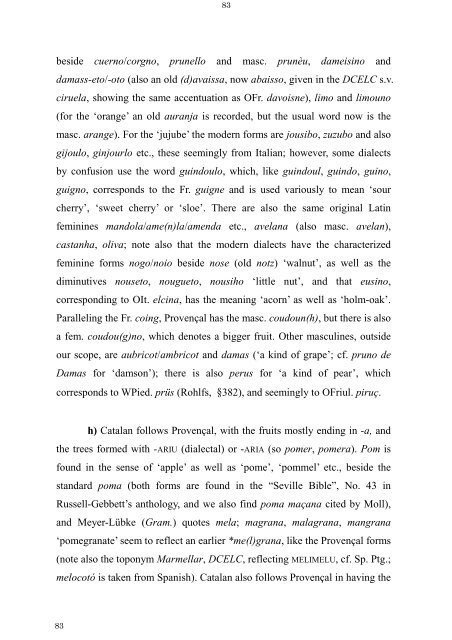The Latin Neuter Plurals in Romance - Page ON
The Latin Neuter Plurals in Romance - Page ON
The Latin Neuter Plurals in Romance - Page ON
Create successful ePaper yourself
Turn your PDF publications into a flip-book with our unique Google optimized e-Paper software.
83<br />
83<br />
beside cuerno/corgno, prunello and masc. prunèu, dameis<strong>in</strong>o and<br />
damass-eto/-oto (also an old (d)avaissa, now abaisso, given <strong>in</strong> the DCELC s.v.<br />
ciruela, show<strong>in</strong>g the same accentuation as OFr. davoisne), limo and limouno<br />
(for the ‘orange’ an old auranja is recorded, but the usual word now is the<br />
masc. arange). For the ‘jujube’ the modern forms are jousibo, zuzubo and also<br />
gijoulo, g<strong>in</strong>jourlo etc., these seem<strong>in</strong>gly from Italian; however, some dialects<br />
by confusion use the word gu<strong>in</strong>doulo, which, like gu<strong>in</strong>doul, gu<strong>in</strong>do, gu<strong>in</strong>o,<br />
guigno, corresponds to the Fr. guigne and is used variously to mean ‘sour<br />
cherry’, ‘sweet cherry’ or ‘sloe’. <strong>The</strong>re are also the same orig<strong>in</strong>al <strong>Lat<strong>in</strong></strong><br />
fem<strong>in</strong><strong>in</strong>es mandola/ame(n)la/amenda etc., avelana (also masc. avelan),<br />
castanha, oliva; note also that the modern dialects have the characterized<br />
fem<strong>in</strong><strong>in</strong>e forms nogo/noio beside nose (old notz) ‘walnut’, as well as the<br />
dim<strong>in</strong>utives nouseto, nougueto, nousiho ‘little nut’, and that eus<strong>in</strong>o,<br />
correspond<strong>in</strong>g to OIt. elc<strong>in</strong>a, has the mean<strong>in</strong>g ‘acorn’ as well as ‘holm-oak’.<br />
Parallel<strong>in</strong>g the Fr. co<strong>in</strong>g, Provençal has the masc. coudoun(h), but there is also<br />
a fem. coudou(g)no, which denotes a bigger fruit. Other mascul<strong>in</strong>es, outside<br />
our scope, are aubricot/ambricot and damas (‘a k<strong>in</strong>d of grape’; cf. pruno de<br />
Damas for ‘damson’); there is also perus for ‘a k<strong>in</strong>d of pear’, which<br />
corresponds to WPied. prüs (Rohlfs, §382), and seem<strong>in</strong>gly to OFriul. piruç.<br />
h) Catalan follows Provençal, with the fruits mostly end<strong>in</strong>g <strong>in</strong> -a, and<br />
the trees formed with -ARIU (dialectal) or -ARIA (so pomer, pomera). Pom is<br />
found <strong>in</strong> the sense of ‘apple’ as well as ‘pome’, ‘pommel’ etc., beside the<br />
standard poma (both forms are found <strong>in</strong> the “Seville Bible”, No. 43 <strong>in</strong><br />
Russell-Gebbett’s anthology, and we also f<strong>in</strong>d poma maçana cited by Moll),<br />
and Meyer-Lübke (Gram.) quotes mela; magrana, malagrana, mangrana<br />
‘pomegranate’ seem to reflect an earlier *me(l)grana, like the Provençal forms<br />
(note also the toponym Marmellar, DCELC, reflect<strong>in</strong>g MELIMELU, cf. Sp. Ptg.;<br />
melocotó is taken from Spanish). Catalan also follows Provençal <strong>in</strong> hav<strong>in</strong>g the









